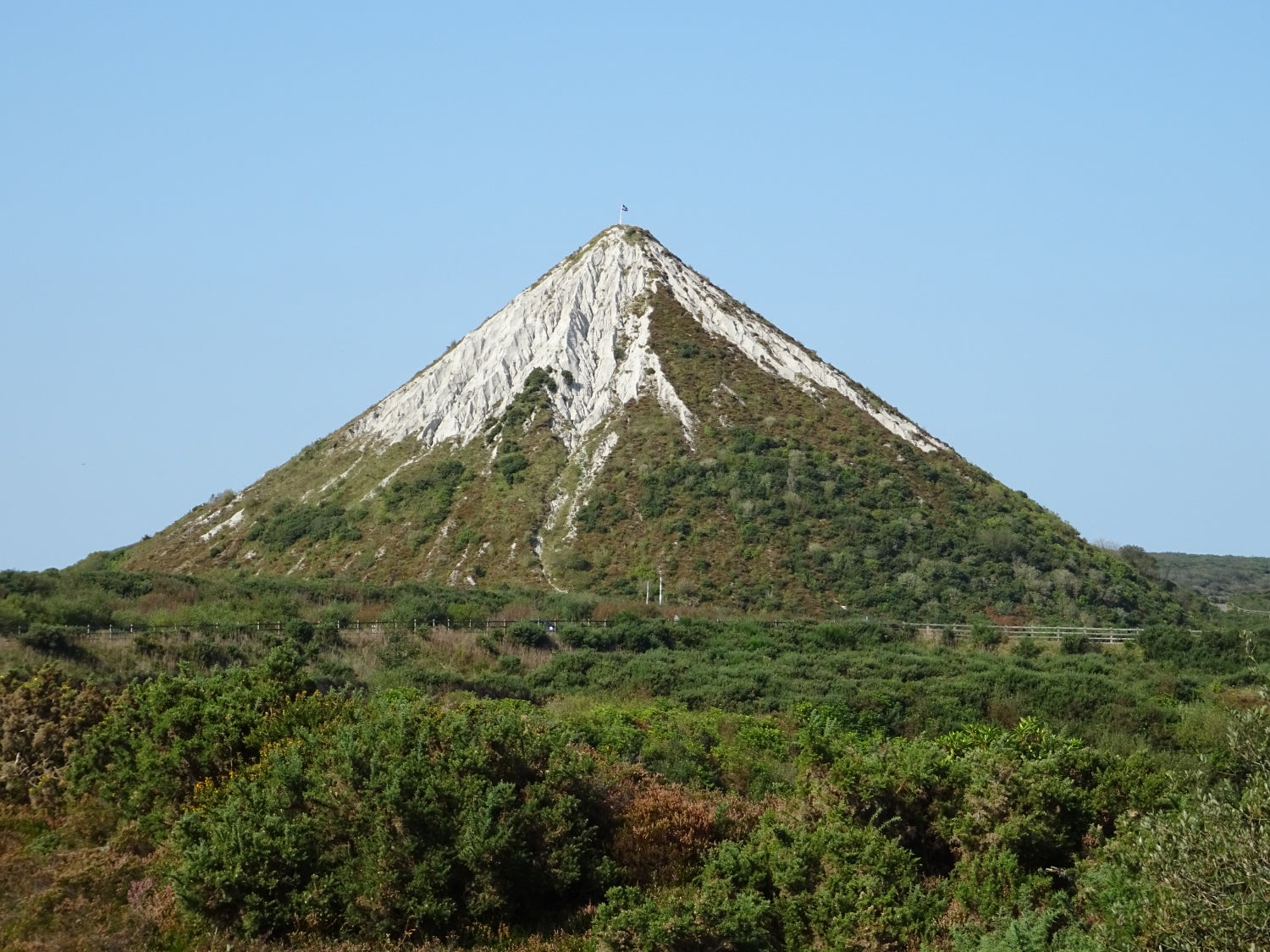The Independent's journalism is supported by our readers. When you purchase through links on our site, we may earn commission.
Cornish white gold: How the search for china clay shaped Cornwall’s coastline
Tamara Hinson heads to the heart of clay country


Think of Cornwall and you might picture wave-bashed Newquay or seagull-splattered Padstow. St Austell often slips under the radar – so much so that many visitors miss the mini-Mount Fuji towering over the town, with its white peak, dark heather blanketing its lower slopes and the Cornish flag, stabbed into its summit by proud locals.
There’s a reason why people here have a deep-rooted fondness for this mountain, topped not with snow but the by-products of the search for Cornwall’s white gold: china clay, otherwise known as kaolin. It’s a search that's shaped the entire area.
At Charlestown Harbour, on the outskirts of St Austell, Daniel Scholes from the Shipwreck Treasure Museum dodges selfie sticks to point out a cluster of fishermen’s cottages. This was the original Charlestown.
Everything changed in the 1700s with the arrival of William Cookworthy, who’d noticed how wealthy westerners paid small fortunes for porcelain shipped from China. He travelled the length and breadth of the UK searching for a similar material, striking gold when he discovered an enormous deposit of china clay near St Austell.
Demand exploded. A harbour was blown out of the cliffside with dynamite, and tunnels were constructed to transport clay to the boats.
The Shipwreck Treasure Museum sits atop these tunnels, built in the 1900s and due to reopen to the public in December 2020 (they first opened in 2019). The entire harbour, an instantly recognisable backdrop for Poldark, is listed and the tunnel’s entrance is tucked into a corner of a Joules clothing store.
In their clay-lined confines, Daniel points to openings in the roof. Blocks of clay would be dropped down chutes, tumbling into wagons that clattered towards the harbour. Ships entered on the left to offload coal destined for the riverside quarry-powering blacksmiths that sprang up, before being filled with clay. One side of the harbour was mired in a permanent cloud of coal dust, the other with fine china clay – hence its moniker as the black and white harbour.
There was a constant queue of ships; locals crossed the harbour by walking across boat decks, rather than around its perimeter, and roads were widened to allow for the huge number of horse-drawn carriages galloping towards the dockside.
The nearby Wheal Martyn museum, where many volunteers are former clay quarry workers, is wedged between two former quarries. I’m shown around by Malcolm Gould, the great, great grandson of a quarry worker and an engineer currently employed by Imerys, the only company still mining china clay in Cornwall (today, the biggest mines are in America and Brazil). Cornwall’s china clay is still being sent all over the world, and used not only to produce ceramics but also to make everything from paper and toothpaste to skincare creams and pharmaceutical products.
The pathway that weaves through the museum’s grounds is dotted with faded photos. My favourite depicts bowler-hatted captains – senior quarry employees – standing knee-deep in liquified clay. Others depict miserable-looking quarrymen manning the hoses used to wash down the clay.
“If you didn’t attend the same church as the quarry’s captain, you’d never get promoted,” reveals Malcolm. “Most started their clay career as kettle boys, brewing tea and baking workers’ Cornish pasties,” he adds.
We pass art-like displays of ancient, cherry-red plunger pumps and a creaking water wheel, restored by retired quarry workers. Malcolm points out that there’s a reason the finest inventors hailed from Cornwall, where tin was mined long before clay. It was a proving ground for some of the engineering world’s greats, such as Cornish mining engineer Richard Trevithick, who designed the world’s first high-pressure steam engine.
As the greed for white gold deepened, new machinery was needed, and Malcolm cites the beam engine as an example of how the region’s passion for china clay turned it into a hotbed of engineering innovation. First used in 1705 to remove water from Cornish mines, the design was tweaked by James Watt. A staple of Cornwall’s quarries, it was a game-changer that transformed the industry worldwide.
We reach a viewing point overlooking the depths of a working quarry owned by Imerys. In the distance, I spot a disused pit filled with water the colour of the Caribbean sea. Malcolm explains that this is due to the presence of highly-reflective mica, which mirrors the colour of the sky.
Next to a newt-filled pond, where he explains that piles of china clay waste weren’t left uncovered but turned into the grassy Cornish Alps that now dot the region. Hi-tech gadgets carpet-bombed the scarred earth with seeds. Rhododendrons grew particularly well, and Malcolm comments that the entire process has gone full circle – rhododendrons were brought here by plant collectors returning from Asia, a region with an insatiable thirst for china clay, after the depletion of their own supplies.
One of the most famous reminders of Cornwall’s burgeoning clay industry is the Eden Project, handily connected to St Austell by a hiking and cycling path that's part of the area’s so-called Clay Trails.
At a time when we’re plundering our natural resources, the Eden Project is a reminder that regeneration is possible. Nestled inside a former clay pit, the huge domes contain plants from all over the world. The winding pathways are lined with pictures documenting the transformation.
Prior to its 2001 opening, torrential downpours flooded the site. Engineers came to the rescue once more, developing new techniques to drain huge amounts of water in minimal time – another reminder of how Cornwall’s clay mining history continues to shape the region.
Travel essentials
Staying there
Rooms at the Premier Inn St Austell start from £49 per night.
More information
England is on lockdown until 2 December, during which leisure travel is illegal. After lockdown lifts, Cornwall will be classed as a tier 1 region. Read our guide to what this means for travel here.
Visit www.wheal-martyn.com and www.shipwreckcharlestown.co.uk for latest opening details.
Join our commenting forum
Join thought-provoking conversations, follow other Independent readers and see their replies
Comments

Bookmark popover
Removed from bookmarks